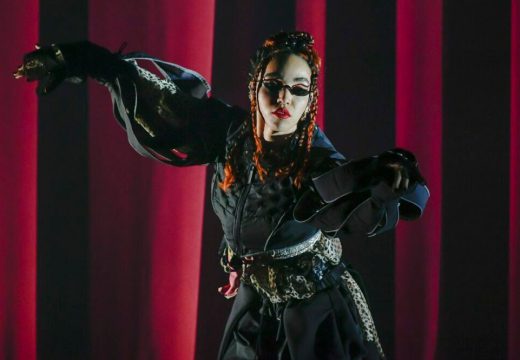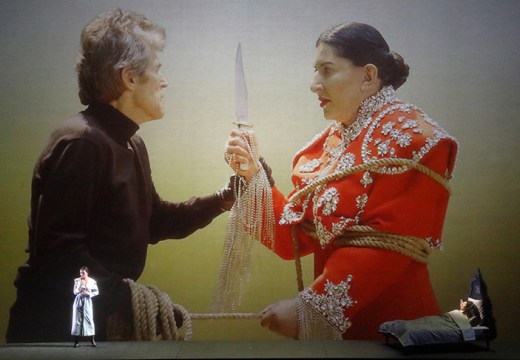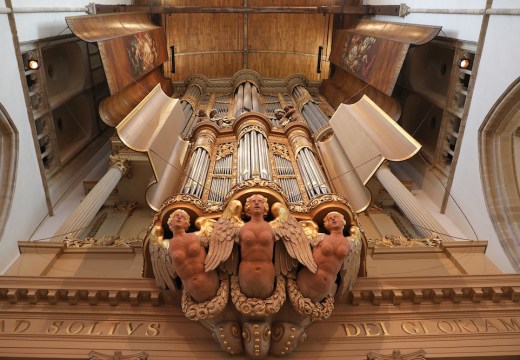From the May 2023 issue of Apollo. Preview and subscribe here.
‘False picture, you have deceived me!’ Images regularly enchant, beguile and mislead in the works of George Frideric Handel (1685–1759), and Ottone, his operatic hit of 1723, was no exception. When we first meet our heroine Teofane, she appears clutching a portrait of her future husband, distraught that the man claiming to be him looks totally different. Turning to the likeness that won her heart, she sinks into a lament that supposedly pleased its maker so much that he threatened to throw his prima donna out of a window for suggesting he write something else.
That a painting should fire the composer’s imagination would not have surprised contempories. According to Dr Johnson’s friend John Hawkins, the composer ‘was a lover of pictures, and for many years before his death frequented, for the purpose of viewing them, all the collections exposed to sale’. But the creator of Messiah was no idle browser. Through purchases and gifts, he amassed an unusually large collection for a commoner, comprising at least 80 paintings and 60 prints. To the frustration of musicologists and art historians, this visual ensemble was dispersed on its owner’s death and details about it are patchy. The chief source is a sole, battered copy of the catalogue accompanying the auction of most of Handel’s collection in 1760, a brief list that describes the prints clearly enough, but which is of little help tracking the paintings. There are some promising candidates out there, like the canvas by Pier Francesco Mola in the Ashmolean Museum recalling the ‘Narcissus in a Landscape’ given to the artist, though such similarities are hardly conclusive when other versions exist and copies surely proliferated. And that is assuming the sellers identified the right painter. Like many period catalogues some attributions were probably wildly optimistic, but there are also claims for big names Handel might have met, and so it is perhaps with an equal measure of fantasy and accuracy that the sources mention a Poussin and Rembrandts, Watteaus and a Canaletto.

Echo and Narcissus (1633–41), Pier Francesco Mola. Ashmolean Museum, Oxford
Handel’s interest in art seems to have started early. At the age of 22, having recently swapped his native Saxony for Rome, it is said that he was wooed to work for Cardinal Colonna with the promise of a ‘very fine picture’ of his would-be patron. The three years he spent in Italy doubled up as a Grand Tour, and Britain can only have whetted his appetite further. For around a decade after his first trip in 1710, Handel often found himself living among Poussins and Veroneses in some of the country’s most culturally progressive piles, especially Burlington House and Cannons. Here he also found artists who became friends, who likely shaped his tastes.
London was the place for Handel to start collecting himself. The largest, most economically liberal metropolis in Europe had become the centre of the continent’s art trade, and it was also where musicians could make money. In the words of the composer’s friend Johann Mattheson, ‘in Italy and France there is something to be heard and learned; in England there is something to be earned’, and Handel’s entrepreneurialism even extended to selling a print of himself. As he became more successful, his ability to collect grew. By his mid sixties, when he went on a shopping spree in London’s salerooms, he could afford to spend a hefty £39 18s for a landscape attributed to Rembrandt.
No less remarkably for a musician, Handel also had a home to display his purchases: a new build on Mayfair’s Brook Street, which he moved into months after the triumph of Ottone, in July 1723. Arriving as a tenant and a foreigner, he was still there at his death more than three decades later, still renting but by now an Englishman entrenched in his castle. Here he was able to curate his collection with leisure itinerant colleagues could only envy, and by his later years nearly every wall of his comfortable if modest dwelling must have been covered with prints and paintings jostling for attention.
When Alison Meyric Hughes and Martin Royalton-Kisch wrote about Handel’s collection in the September 1997 issue of Apollo, picturing the assemblies of works was even harder than it is now. Divided into offices and a shop, his home bore few signs of its most famous occupant, and there were even fewer chances to explore inside. Their article was part of an attempt to rectify this situation, which culminated in 2001 with the opening of a museum that returned the property to a state the composer might have recognised, complete with some period prints and pictures hinting at what was once there.

Diana on a Stag Hunt (Servatur Exemplar) 18th century, Joseph Goupy after Peter Paul Rubens. Fine Arts Museums of San Francisco
Now there is cause to imagine the rest with renewed energy. Later this month, in time for the 300th anniversary of Handel getting the keys, the house will reopen after a major refurbishment that has at last added the ground floor to the museum, revealing the full wall space at the composer’s disposal. The chance to view more art in new rooms is sure to make us think again about what Handel saw in his paintings. Surrounding the composer wherever he wrote, rehearsed or cleared his head, it is difficult to believe that the collection was the distinct hobby Hawkins thought and, sure enough, the sale catalogue suggests many crossovers between Handel’s pictures and his music.
There are the reminders of career highlights, such as a view by Canaletto of Venice, where the composer had his first big operatic success with Agrippina (1709). A number of the more recent works were also by artists who painted his stage sets, most notably his friend-cum-adversary Joseph Goupy, a name that appears throughout the catalogue.
But the ties between Handel the collector and Handel the composer could go deeper still. Several of his pictures depicted stories he set to music, and still more illustrated familiar genres, plus imagery that recurs repeatedly in his operas and oratorios. It is impossible to say how daily encounters with these works shaped the thinking of the composer, a question that must also have crossed the minds of guests versed in ut pictura poesis and contemporary theories on the relationship between the arts. Unsure though we are about just what these visitors saw, we can play the same intellectual game, sketching the collection while imagining parallels between it and Handel’s output.
His was a varied assembly. There were flower paintings, genre scenes and religious images – including prints of Tridentine altarpieces and a mocking picture of ‘Two Monkeys in Friars Habits’. There were also outliers which may have been gifts or just took his fancy, such as topographical prints of Malta, but the bulk of Handel’s collecting energies were channelled into history painting and landscape. These preferences were very much of their time, and most of the lots give the impression of a buyer who was almost impeccably conventional in his tastes. Fashionable contemporaries and sought-after names from the previous century are plentiful, and there is even the odd example attributed to the Carracci. With Raphael, the biggest name of all, Handel would have been outbid, but he could still admire Nicolas Dorigny’s engravings of a work he must have seen in Rome: the cupola of the Chigi Chapel in Santa Maria del Popolo.
As a musician Handel was often at his most creative working within norms rather than challenging them. If, as a collector, he was following received wisdom by prizing narrative pictures, he did so as a man of the theatre who saw narrative drama as the composer’s highest genre. Around two dozen religious and mythological scenes lined Handel’s walls, supposedly by everyone from Andrea del Sarto to Sebastiano Ricci, an artist the composer surely encountered when they both worked at Burlington House and Cannons. Many of these pictures had very familiar stories, including two of the pieces by Goupy: a print after Rubens of Diana the Huntress, subject of a youthful cantata written in Rome, and a watercolour of Gaius Mucius Scaevola, paradigm of ancient virtue and hero of a collaborative opera (Muzio Scevola) for which Handel wrote the final act. Goupy began making sets for Handel’s opera company around the premiere of Muzio in 1721, and it is not impossible that the painting changed hands before his friend started composing, though in time this picture became a souvenir of a key win that helped confirm Handel’s status in Britain. Muzio had been devised as a competition to settle arguments about who was London’s best composer, and as the final chorus wound the story up, most had decided that Handel had carried the day.
Brook Street’s walls also displayed prequels and sequels to stories Handel had brought to life. Works such as Cornelis van Poelenburgh’s picture of Ariadne meeting Bacchus after being abandoned by Theseus, which gave an alternative afterword to her betrothal to the Athenian hero at the end of the opera Arianna in Creta (1734). Poelenburgh was first and foremost a landscape painter, and in all of his surviving renditions of this story narrative plays second fiddle to the scenery. Assuming that Handel’s picture followed suit, the setting may have attracted the buyer together with the subject. Landscape was the most prominent genre at Brook Street, accounting for about half of the recorded works, including the highest-ticket items like the ‘Rembrandts’, plus a supporting cast of equally fashionable pieces, from Herman van Swanevelt’s imaginary Roman countryside to the Campanian badlands of Salvator Rosa. However in vogue the choices, this concentration of landscapes was more unusual. A lifelong city dweller can be expected to have indulged in some rural escapism, but ostensible narratives such as Poelenburgh’s Ariadne or Abraham Hondius’s ‘landscape with Vulcan’s forge’ make one wonder if Handel was more interested in the dramatic potential of the genre.

Gaetano Berenstadt as Flavio, Francesca Cuzzoni as Emilia and Francesco Bernardi, or Senesino, in Handel’s opera Flavio, King’s Theatre Haymarket, 14 May 1723 (1723), artist unknown. Victoria and Albert Museum, London
‘Here in their own tongues the stream, grasses and beech speak of love to my enraptured heart.’ The smitten Prince Ariodante is one of many Handelian leads who seems to inhabit a painted landscape, an idealised setting evoking Mola’s Narcissus. Handel’s audience needed little help visualising such a scene. According to the few visual records, his operas were staged in front of painted countrysides, and several of these sets were by artists responsible for pastoral works at Brook Street. Marco Ricci, notably, contributed three landscapes to the collection, and faced with reminders like these the composer could hardly have avoided conflating his own output with his scenic pictures.
In Handel’s world, however, landscape was never just a backdrop. Repeatedly he put it centre stage, especially in the bucolic score of his most popular work before Messiah, the pastoral drama Acis and Galatea, which may have had its first performance in the gardens of Cannons. Still more frequently, the sights and sounds of a landscape were marshalled, as in Ariodante’s soliloquy, to convey characters’ feelings. At Brook Street, prints after Rosa and offerings by the more overtly Dutch painters mixed with Claudian works to create a bank of imagery that could be raided for the purposes of pathetic fallacy: northern seas as well as southern scenes, the desolate beside the picturesque and a gamut of greys to contrast the rich palettes of Ricci’s efforts. At times there must have been abrupt changes of mood between one landscape and its neighbours, just as Handel’s protagonists refer to changes of sun, sea and sky to process the rollercoaster of emotions they are whipped through. Dark nights yield to bright days, barren meadows are revived and, most regularly of all, souls tossed on stormy waves seek safety in port. Reflecting on their happy ending in one of the composer’s most celebrated arias (‘Dopo notte’), a relieved Ariodante uses a common Handelian metaphor: ‘My boat was almost submerged in that horrid tempest, but it reaches for the shore as it returns to port.’ Inspiration for some of Handel’s most vivid music, this stock emotional journey was played out on his walls with a ‘fresh Gale’ attributed to Jan Porcellis and a ‘Calm’ in the same lot.

George Frideric Handel (1726–28), attrib. Balthasar Denner. National Portrait Gallery, London
At the start of a routinely busy 1750, landscapes were firmly on Handel’s mind. According to one account he was busy ‘pleasing himself in the purchase of several fine pictures’, including the £39 Rembrandt, but though he would live for almost another decade, his days as a collector were nearly over. Before long his eyesight started to deteriorate, and by the following February things had become so bad that he stopped working on his most intimate oratorio, Jephtha, as he finished the chorus ‘How Dark, O Lord, are thy decrees, all hid from mortal sight’. While he managed to resume work and write the final act, Jephtha would be Handel’s last new work for the stage. By August 1752 he was totally blind. During a performance of Samson in 1753, both Handel and audience were moved to tears when the hero laments losing his sight (in the air ‘Total Eclipse’). Back at home, the composer could no longer see his picture of Samson by Giovanni Antonio Pellegrini.
In 1757, he dictated a codicil to his will gifting paintings he could touch but had not enjoyed in years, notably the ‘Rembrandts’, plus two ‘heads’ by his sometime portraitist Balthasar Denner, which a grateful composer left to a fellow collector, Messiah librettist Charles Jennens.
Handel died at Easter in 1759, and the remaining pieces were auctioned the following February. Just two days before the sale the composer’s first biography was advertised in the press. His memorialisation had already begun, but the display of the collection gave London another glimpse of Handel the man. Months before his death, in one of his last acts as a composer, he had decided to revise his oratorio Solomon; reflecting on the riches accumulated over a life like few others, visitors to the sale might have done worse than adapt lines uttered by the Queen of Sheba as she takes her leave, in a rare number Handel left unchanged: ‘E’er can banish from her thought, all the splendour she has seen?’
Handel’s house on Brook Street, London, reopens on 18 May.
From the May 2023 issue of Apollo. Preview and subscribe here.
Unlimited access from just $16 every 3 months
Subscribe to get unlimited and exclusive access to the top art stories, interviews and exhibition reviews.














![Masterpiece [Re]discovery 2022. Photo: Ben Fisher Photography, courtesy of Masterpiece London](http://www.apollo-magazine.com/wp-content/uploads/2022/07/MPL2022_4263.jpg)
It’s time for the government of London to return to its rightful home